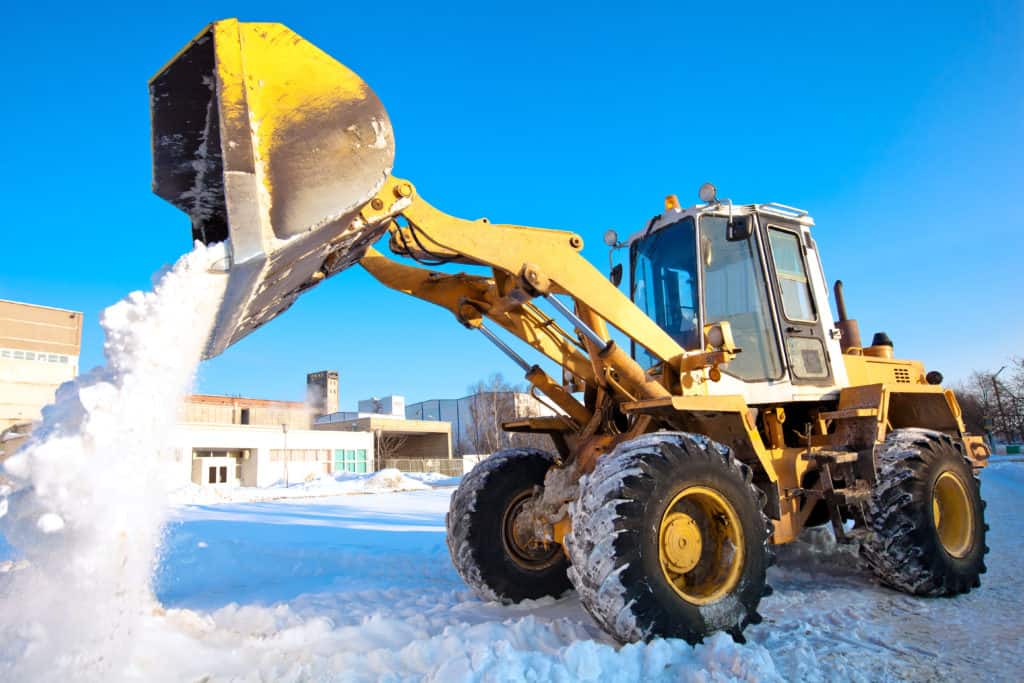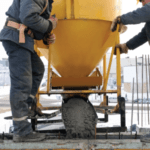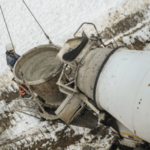Construction crews deal with an added layer of difficulty in the freezing winter months. Tasks that are simple and straightforward in warmer weather suddenly take more time and come with more personal risk to the construction crew. Common practices may need to be altered to approach a winter project in a safer way, while maintaining time efficiency in order to meet deadlines. Here are five helpful winter construction tips to keep your projects on schedule.
1- Keep Your Employees Safe
Safety on job sites should always be the top priority of general contractors. As the person overseeing the crew’s efforts, it falls to you to ensure that the amount of personal risk to each of your employees is minimal. Construction comes with a certain level of risk at any time of the year, but it is greatly heightened during the winter months. Extra precautions should be created and regularly enforced. This not only protects your workers – it also keeps your project moving along at a good pace to meet your deadline and increases overall efficiency.
Here are some of the most common winter construction dangers your crew may face:
- Increased Risk of Slipping Due to Ice
- Falls From Great Heights
- Cold Stress
- Injuries from Snow Removal Machinery
- Accidents Due to Limited Mobility From Personal Protective Clothing
Workers may experience negative symptoms from working in the cold for long hours. General contractors are responsible for providing frequent breaks in heated areas. Proper protective clothing should be encouraged. Even with this clothing, always be on the lookout for signs of cold stress in the form of hypothermia, frostbite, or trench foot. These include sudden clumsiness, slurred speech, numbness, grey-looking skin, weakness, and tingling. Encourage your workers to look for the signs in themselves and their coworkers.
One of the main ways you can protect your employees is to remove snow and ice before any work takes place. If you use traditional snow-removal methods, such as shoveling, the ground will likely still be slippery due to a remaining thin layer of ice. Always add ice melt to the surfaces to ensure that risk of falling is kept to a minimum. This absolutely applies to those working at great heights such as scaffoldings as well. One of the number 1 ways workers get injured, or even die, is from falling accidents. Don’t let it be on your watch.
At Powerblanket, we are dedicated to supplying our customers with construction heating solutions that really work. We offer the very best in snow removal to keep your construction workers on safe job sites. Consider our top-of-the-line snow melting mats for your next project.
SummerStep Snow Melting Mats:
- Protect personnel from winter weather conditions and keep stairs, doorways, walkways, and ramps free from snow and ice.
- Prevent slips and falls
- More convenient than shoveling snow (and safer too!)
- More effective for snow and ice melting than harsh chemicals (less damaging to the environment, reusable, won’t damage concrete or other flooring surfaces.)
- Will melt approximately 2 inches of snow per hour when operating
- 40 Watts/Sq Ft heated area
- The ONLY snow-melting mat product made in the USA
2- Maintain Integrity of Concrete
In addition to creating a safe work environment, other factors contribute to your winter construction efficiency. One of these is maintaining the integrity of your concrete. Pouring concrete in cold weather takes longer than in warmer months. This is because the concrete will set more slowly. Not only will it take more time, but concrete is also more high-maintenance in the cold because it cannot freeze while curing, yet it is in great danger of doing just that. If it freezes within the first 24 hours, the concrete can weaken by up to 50 percent, leaving your work unsatisfactory to customers in the long run. And no construction company wants that, right?
When working with concrete in the winter, it’s not just the actual concrete you need to think about. Never pour concrete on frozen ground. When the ground thaws in the future, it can settle and cause concrete cracking issues.
Avoid the headache – do it right the first time.
Here are just a few general tips for winter concrete work to help you out:
- Mix Cement with Hot Water
- Use Quick-Set Cement
- Keep Concrete Between 50-60 Degrees Fahrenheit Once Poured
Want to know the most efficient way to cure that cold-weather concrete? Use Powerblanket’s Concrete Curing Blankets!
Here are just a few of the many benefits general contractors can expect with our concrete curing blankets:
- Cure Concrete 2.8 Times Faster Than Conventional Insulated Blankets
- Product Cold Weather Concreting Strength of 3,925 psi In 72 Hours
- Maintain Moisture Throughout Hydrating Process
- Easily Installed and Removed
- Maintain ACI Compliance for Cold-Weather Concreting Certified to UL and CSA Standards
3- Don’t Let Frozen Ground Slow You Down
Ever gotten to a site, only to realize that the ground was frozen solid? Certainly not the best working conditions, especially when it comes to efficiency. Frozen ground means at least twice the effort with about half the reward. It’s an absolute “no-go” if you want to keep your project moving along at a consistent pace.
Whether you’re digging trenches or working with earthmoving equipment to excavate a build site, you need ground that is ready for the job. When earth freezes, it can go down a foot or more, leaving very little chance of successfully preparing the ground for your project’s next steps. This can cause time delays, increase stress, and strain relationships with your customers. In the end, the customer simply wants the job done and does not factor in all the weather variables that may affect the final deadline. That’s your job.
But Powerblanket is here to help! Here are the benefits of choosing our ground thawing blankets for your projects.
- High Power Density Capabilities Thaw Frozen Ground Quickly
- Remove Frost Prior to Concrete Pour
- Melt Snow and Ice from Roofs, Walkways, and Construction Areas
- Easily Placed and Removed for Repeated Use In Harsh Weather
- Certified to UL and CSA Standards
4- Keep Materials Warm
Perhaps one of the fastest ways to lose out on potential profits for the company is failing to protect your valuable materials. General contractors know just how important it is to save their materials, as the initial price bid given to the customer is dependent on how much material will be used, and how much it will cost. Failing to store and maintain the materials at the appropriate temperatures will affect the bottom line, causing big profit loss, or even losing money on a project.
So why not avoid the disappointment and get it right the first time? Whether it’s paint, epoxy, plaster, concrete, gases, or any other materials you work with regularly, get them covered so they work for you when you need them most.
The smart choice is Powerblanket’s Hot Box. Check out our bragging rights for this incredible product.
Quick and Easy Assembly
- Preserve Temperature Sensitive Material
- Keep Products From Freezing or Overheating
- Adjustable Thermostatic Controllers
- Hold Products Between 100-120 Degrees Fahrenheit.
- Heat Materials and Palletized Products: Adhesives, Shingles, Paint, Caulk, Resins Epoxies, etc.
- Access Doors on Two Sides
- Certified to UL and CSA Standards
5- Use a Propane Heater
Whether propane serves to keep your vehicles running, keeps your water running, or your workers warm, it’s essential to the winter construction job site. When propane freezes in the tank, it becomes utterly useless. Tanks will freeze when they reach -44 degrees fahrenheit. Cold weather also decreases the propane tank’s extraction rate, which is how quickly and smoothly you can extract propane from the tank.
Without propane…
Your crew can’t use its vehicles for the various tasks at hand, and the heavy cost is decreased efficiency on the entire project.
A lack of ready-to-use water leads to complications with concrete and other materials, as well as cleaning.
Improper heating can stall important tasks such as drywall installation and painting.
Not to mention those grumpy, freezing workers. So that’s fun, right?
Keep your propane flowing the way it’s meant to with Powerblanket’s Propane Tank Heaters!
- Increase performance and efficiency of propane tanks
- Eliminate unnecessary cylinder refills in cold weather
- Even heat distribution in the areas where it is most needed
- Save money by optimizing gas and material usage
- Certified to UL and CSA Standards
Simply put, we at Powerblanket are 100% dedicated to keeping your construction projects running smoothly and efficiently all year long. Don’t fall victim to the pains that winter can bring.
Experience the Powerblanket difference. Call our experienced team today at 801.506.0198.
Frequently Asked Questions
Can you do construction during winter?
Yes, construction can continue during winter, but it requires careful planning and safety measures to address challenges like reduced visibility, cold stress, and icy surfaces.
How cold is too cold for construction?
Construction should be postponed or moved indoors when temperatures drop below 10°F, as the risk of hypothermia and frostbite becomes too high for workers.
What do construction companies do in winter?
During winter, construction companies often focus on maintaining equipment, planning future projects, and managing financial tasks like bookkeeping and tax preparation.
Is it OK to build a house in the winter?
Building a house in winter is feasible with an experienced team that uses appropriate materials and techniques to adapt to cold weather conditions.
Don't let the cold weather stop you, and keep your construction project on schedule. Powerblanket has you covered.






